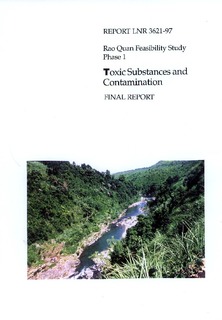| dc.contributor.author | Berge, D. | nb_NO |
| dc.contributor.author | Knutzen, J. | nb_NO |
| dc.contributor.other | Berge, D. - Project manager | nb_NO |
| dc.coverage.spatial | Vietnam | nb_NO |
| dc.date.accessioned | 2014-08-01T10:40:38Z | |
| dc.date.available | 2014-08-01T10:40:38Z | |
| dc.date.issued | 1997 | nb_NO |
| dc.identifier | 3621 | nb_NO |
| dc.identifier.isbn | 82-577-3177-3 | nb_NO |
| dc.identifier.issn | 1894-7948 | nb_NO |
| dc.identifier.uri | http://hdl.handle.net/11250/209277 | |
| dc.description.abstract | The three rivers Rao Quan, Khe Nghi, and Quang Tri contain relatively soft water with a calcium content from 3 - 17 mg/l. The pH value varies from 7-9. The alkalinity varies from 0.4-1.4 mMol/l which indicates good buffer capacity against acidification. The sulphate concentration is also low. The water will not be aggressive against concrete material. The turbidity of the water varies from 1,8 FTU in the dry season to 16 FTU in the wet season. This indicates a maximum particulate content of 17 mg/l in the wet season, which is rather low. The nutrient content of the rivers is relatively low. The phosphorus content (8-35 µgP/1)correlated well with the turbidity, which indicates that the phosphorus is bound to particles. Khe Nghi has significantly higher nitrogen content (380 µgN/l) than the other rivers, which may indicate some slight impact from animal husbandry. However, no sign of eutrophication is noticed. The content of heavy metals is low and indicates no pollution from the military activity in the area. The water has good quality for irrigation purposes. There was no indications from the analysed fish, river sediments or rice field top soil samples from the Rao Quan area of dioxin contamination of any practical significance. The content was similar to back ground levels that can be found everywhere due to diffuse atmospheric fallout. In relation to spreading of Agent Orange in 1962-1975 duriing the war, contamination in Quang Tri Province is hardly to be expected, as the application of this herbicide mainly took place in the southernmost part of the country. | nb_NO |
| dc.description.sponsorship | Statkraft Engineering A/S | nb_NO |
| dc.publisher | Norsk institutt for vannforskning | nb_NO |
| dc.relation.ispartofseries | NIVA-rapport;3621 | nb_NO |
| dc.rights | Navngivelse-IkkeKommersiell-DelPåSammeVilkår 3.0 Norge | nb_NO |
| dc.rights.uri | http://creativecommons.org/licenses/by-nc-sa/3.0/no/ | nb_NO |
| dc.subject | internasjonale aktiviteter | nb_NO |
| dc.title | Rao Quan Feasibility study - Phase 1: Toxic substances and contamination (Final report) | nb_NO |
| dc.type | Research report | nb_NO |
| dc.rights.holder | Norsk institutt for vannforskning/Norwegian institute for water research | nb_NO |
| dc.subject.nsi | VDP::Matematikk og naturvitenskap: 400 | nb_NO |
| dc.source.pagenumber | 35 | nb_NO |
| dc.subject.keyword | vannkraft | nb_NO |
| dc.subject.keyword | oppdemming | nb_NO |
| dc.subject.keyword | krigsforurensning | nb_NO |
| dc.subject.keyword | dioxin | nb_NO |
| dc.subject.keyword | tungmetall | nb_NO |
| dc.subject.keyword | hydropower | nb_NO |
| dc.subject.keyword | damming | nb_NO |
| dc.subject.keyword | war | nb_NO |
| dc.subject.keyword | time | nb_NO |
| dc.subject.keyword | contaminants | nb_NO |
| dc.subject.keyword | dioxin | nb_NO |
| dc.subject.keyword | heavymetal | nb_NO |
| dc.relation.project | O-96190 | nb_NO |


